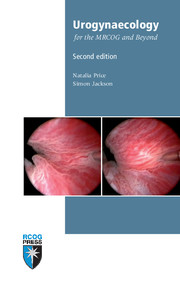Book contents
- Frontmatter
- Contents
- Preface
- Abbreviations
- 1 Applied anatomy and physiology of the lower urinary tract
- 2 Definition and prevalence of urinary incontinence
- 3 Initial assessment of lower urinary tract symptoms
- 4 Further investigation of lower urinary tract symptoms
- 5 Management of stress urinary incontinence
- 6 Management of overactive bladder syndrome
- 7 Recurrent urinary tract infection
- 8 Haematuria
- 9 Painful bladder syndrome and interstitial cystitis
- 10 Pregnancy and the renal tract
- 11 Ageing and urogenital symptoms
- 12 Fistulae and urinary tract injuries
- 13 Pelvic organ prolapse
- 14 Colorectal disorders
- 15 Obstetric anal sphincter injuries
- Index
11 - Ageing and urogenital symptoms
Published online by Cambridge University Press: 05 July 2014
- Frontmatter
- Contents
- Preface
- Abbreviations
- 1 Applied anatomy and physiology of the lower urinary tract
- 2 Definition and prevalence of urinary incontinence
- 3 Initial assessment of lower urinary tract symptoms
- 4 Further investigation of lower urinary tract symptoms
- 5 Management of stress urinary incontinence
- 6 Management of overactive bladder syndrome
- 7 Recurrent urinary tract infection
- 8 Haematuria
- 9 Painful bladder syndrome and interstitial cystitis
- 10 Pregnancy and the renal tract
- 11 Ageing and urogenital symptoms
- 12 Fistulae and urinary tract injuries
- 13 Pelvic organ prolapse
- 14 Colorectal disorders
- 15 Obstetric anal sphincter injuries
- Index
Summary
Lower urinary tract symptoms become increasingly prevalent as women get older. Management of symptoms may be challenging: elderly people are less able to tolerate aggressive surgical and pharmaceutical treatments and their symptoms are more likely to be secondary to multiple causes. This chapter considers the symptoms and pathology that the clinician is likely to encounter in elderly women and how the management differs from that in younger women.
Urinary incontinence
Urinary incontinence is a frequent cause of institutionalisation in elderly people. As in younger people, the common causes of urinary incontinence are detrusor overactivity and sphincter weakness. The effects of ageing on the nervous system and lower urinary tract exacerbate the problems encountered in younger people. Furthermore, in up to 35% of cases, the pathophysiology of the urinary incontinence may be multifactorial.
As in younger women, it is frequently appropriate to determine the exact cause of incontinence within this group, as it is perfectly feasible both to correct sphincter weakness and to treat detrusor overactivity. This will often involve urodynamic investigation, the indications for which are outlined in chapter 4. Cystometry is well tolerated by elderly people although prophylactic antibiotics may be required if they have a predisposition to urinary tract infections. The threshold for performing a urodynamic assessment is lower in elderly women. This is because empirical treatment based on symptom assessment and a urinary diary alone becomes increasingly unsatisfactory as women get older. Elderly people are more likely to have a multitude of coexisting symptoms, and they may have multiple pathologies to account for these.
- Type
- Chapter
- Information
- Urogynaecology for the MRCOG and Beyond , pp. 87 - 92Publisher: Cambridge University PressPrint publication year: 2012

